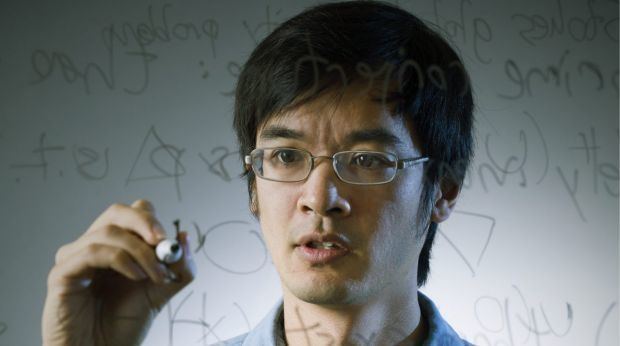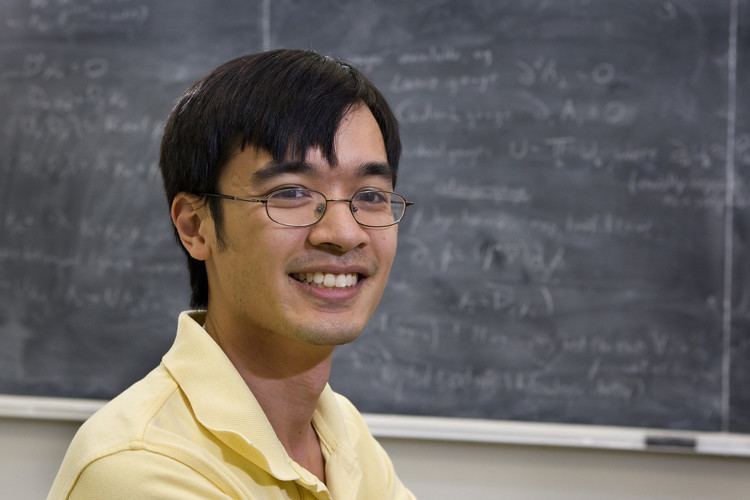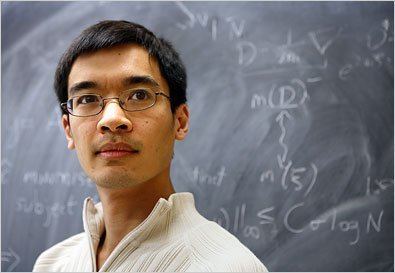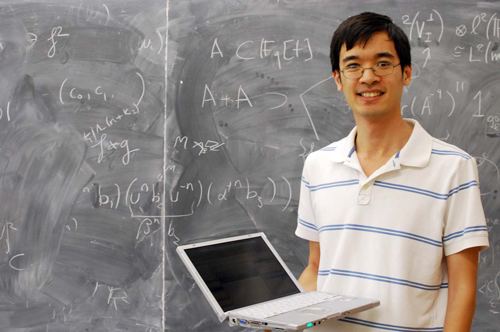Children William Tao Spouse Laura Tao | Role Mathematician Name Terence Tao Parents Billy Tao, Grace Tao | |
 | ||
Nationality AustraliaUnited States Alma mater Flinders UniversityPrinceton University Known for Green–Tao theoremErdos discrepancy problemCompressed SensingTao's inequalityKakeya conjectureHorn Conjecture Books Solving Mathematical Problems, Structure and randomness, Higher Order Fourier A, Analysis, Poincare's Legacies: Pages fro Similar People Kim Ung‑yong, Paul Erdos, William James Sidis, Jean Bourgain, Elias M Stein | ||
Terence tao genius mathematician
Terence Chi-Shen Tao FAA FRS (born 17 July 1975) is an Australian-American mathematician who has worked in various areas of mathematics. He currently focuses on harmonic analysis, partial differential equations, algebraic combinatorics, arithmetic combinatorics, geometric combinatorics, compressed sensing and analytic number theory. As of 2015, he holds the James and Carol Collins chair in mathematics at the University of California, Los Angeles. Tao was a co-recipient of the 2006 Fields Medal and the 2014 Breakthrough Prize in Mathematics.
Contents
- Terence tao genius mathematician
- Terence tao the erd s discrepancy problem
- Family
- Childhood
- Research and awards
- GreenTao theorem and compressed sensing
- Random matrices HardyLittlewood prime tuples conjecture approximate groups
- Higher order Fourier analysis DiracMotzkin conjecture NavierStokes equation Prime gaps Erds discrepancy problem
- Notable awards
- Book publications
- References

Terence tao the erd s discrepancy problem
Family

Tao's father, Dr. Billy Tao (Chinese: 陶象國; pinyin: Táo Xiàngguó), was a pediatrician who was born in Shanghai and earned his medical degree (MBBS) from the University of Hong Kong in 1969. Tao's mother, Grace (Chinese: 梁蕙蘭, English: Leung Wai-lan), is from Hong Kong; she received a first-class honours degree in physics and mathematics at the University of Hong Kong. She was a secondary school teacher of mathematics and physics in Hong Kong. Billy and Grace met as students at the University of Hong Kong. They then emigrated from Hong Kong to Australia.

Tao has two brothers living in Australia, both of whom represented Australia at the International Mathematical Olympiad.


Tao's wife, Laura, is an engineer at NASA's Jet Propulsion Laboratory. They live with their son and daughter in Los Angeles, California.
Childhood

Tao exhibited extraordinary mathematical abilities from an early age, attending university-level mathematics courses at the age of 9. He and Lenhard Ng are the only two children in the history of the Johns Hopkins' Study of Exceptional Talent program to have achieved a score of 700 or greater on the SAT math section while just nine years old. Tao scored a 760. In 1986, 1987, and 1988, Tao was the youngest participant to date in the International Mathematical Olympiad, first competing at the age of ten, winning a bronze, silver, and gold medal. He remains the youngest winner of each of the three medals in the Olympiad's history, winning the gold medal shortly after his thirteenth birthday.
At age 14, Tao attended the Research Science Institute. When he was 15 he published his first assistant paper. He received his bachelor's and master's degrees at the age of 16 from Flinders University under Garth Gaudry. In 1992 he won a Fulbright Scholarship to undertake postgraduate study in the United States. From 1992 to 1996, Tao was a graduate student at Princeton University under the direction of Elias Stein, receiving his PhD at the age of 21. He joined the faculty of the University of California, Los Angeles in 1996. When he was 24, he was promoted to full professor at UCLA and remains the youngest person ever appointed to that rank by the institution.
Research and awards
Within the field of mathematics, Tao is known for his collaboration with Ben J. Green of Oxford University; together they proved the Green–Tao theorem. Known for his collaborative mindset, by 2006 Tao had worked with over 30 others in his discoveries, reaching 68 co-authors by October 2015.
In a book review, the mathematician Timothy Gowers remarked on Tao's accomplishments:
Tao has won numerous honours and awards over the years.
He is a Fellow of the Royal Society, the Australian Academy of Science (Corresponding Member), the National Academy of Sciences (Foreign member), the American Academy of Arts and Sciences, and the American Mathematical Society. In 2006 he received the Fields Medal "for his contributions to partial differential equations, combinatorics, harmonic analysis and additive number theory", and was also awarded the MacArthur Fellowship. He has been featured in The New York Times, CNN, USA Today, Popular Science, and many other media outlets.
By 2016 Tao had published about 300 research papers and 17 books. He has an Erdős number of 2.
Green–Tao theorem and compressed sensing
In 2004, Ben Green and Tao released a preprint proving what is now known as the Green–Tao theorem. This theorem states that there are arbitrarily long arithmetic progressions of prime numbers. The New York Times described it this way:
For this and other work Tao was awarded the Australian Mathematical Society Medal of 2004.
He was awarded a Fields Medal in August 2006 at the 25th International Congress of Mathematicians in Madrid. He was the first Australian, the first UCLA faculty member, and one of the youngest mathematicians to receive the award.
An article by New Scientist writes of his ability:
Tao was a finalist to become Australian of the Year in 2007. He is a corresponding member of the Australian Academy of Science, and in 2007 was elected as a Fellow of the Royal Society. In the same year Tao also published Tao's inequality, an extension to the Szemerédi regularity lemma in the field of information theory.
In April 2008, Tao received the Alan T. Waterman Award, which recognizes an early career scientist for outstanding contributions in their field. In addition to a medal, Waterman awardees also receive a $500,000 grant for advanced research.
In December 2008, he was named the Lars Onsager lecturer of 2008, for "his combination of mathematical depth, width and volume in a manner unprecedented in contemporary mathematics". He was presented the Onsager Medal, and held his Lars Onsager lecture entitled "Structure and randomness in the prime numbers" at NTNU, Norway.
Tao was also elected a Fellow of the American Academy of Arts and Sciences in 2009.
In 2010, he received the King Faisal International Prize jointly with Enrico Bombieri. Also in 2010, he was awarded the Nemmers Prize in Mathematics and the Polya Prize (SIAM) jointly with Emmanuel Candès for their work on Compressed Sensing.
Random matrices, Hardy–Littlewood prime tuples conjecture, approximate groups
In 2007, Tao and Van H. Vu solved the circular law conjecture.
In 2010, joint work with Ben Green culminated in the proof of the Hardy-Littlewood prime tuples conjecture for any linear system of finite complexity.
Tao also made contributions to the study of the Erdős–Straus conjecture in 2011, by showing that the number of solutions to the Erdős–Straus equation increases polylogarithmically as n tends to infinity.
In 2012, he and Jean Bourgain received the Crafoord Prize in Mathematics from the Royal Swedish Academy of Sciences. Also, in 2012, he was selected as a Simons Investigator. He proved that every odd integer greater than 1 is the sum of at most five primes.
Higher order Fourier analysis, Dirac–Motzkin conjecture, Navier–Stokes equation, Prime gaps, Erdős discrepancy problem
In 2012, in joint work with longtime co-author Ben Green, proofs were announced for the Dirac-Motzkin conjecture and the "orchard-planting problem" (which asks for the maximum number of lines through exactly 3 points in a set of n points in the plane, not all on a line). That same year, Tao published the first monograph on the topic of Higher Order Fourier Analysis.
In 2014, Tao received a CTY Distinguished Alumni Honor from Johns Hopkins Center for Gifted and Talented Youth in front of 963 attendees in 8th and 9th grade that are in the same program that Tao graduated from. That year, Tao presented work on a possible attack on the notorious Navier–Stokes existence and smoothness Millennium Problem, by establishing finite time blowup for an averaged three-dimensional Navier-Stokes equation. That year he also, jointly with several co-authors, proved several results on short and long prime gaps.
In September 2015, Tao announced a proof of the Erdős discrepancy problem, using for the first time entropy-estimates within analytic number theory.
Notable awards
He received the Salem Prize in 2000, the Bôcher Memorial Prize in 2002, and the Clay Research Award in 2003, for his contributions to analysis including work on the Kakeya conjecture and wave maps. In 2005, he received the American Mathematical Society's Levi L. Conant Prize with Allen Knutson for a proof of the Horn conjecture, and in 2006 he was awarded the SASTRA Ramanujan Prize.
